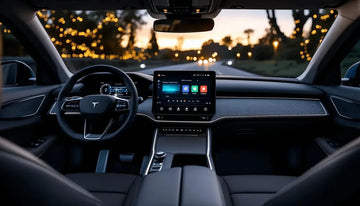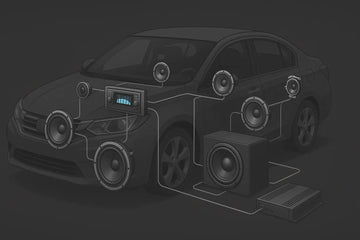Understanding High Audio Frequency: The Complete Guide to 20,000 Hz Audio Spectrum
Mastering high audio frequency understanding is essential for anyone serious about premium car audio performance. From the lowest note at 27.5 Hz (piano's A0) to the highest note reaching 20,000 Hz in the human hearing spectrum, each frequency plays a crucial role in delivering exceptional audio experiences. Whether you're optimizing Dynaudio component speakers or fine-tuning Xcelsus tweeters, understanding the complete audio frequency range transforms ordinary car audio into extraordinary sonic perfection.
The Science Behind High Audio Frequency and Human Hearing
High audio frequency represents the upper spectrum of human hearing, typically ranging from 4,000 Hz to the maximum 20,000 Hz threshold. This critical frequency range encompasses treble, presence, and brilliance frequencies that define audio clarity, detail, and spatial characteristics in premium car audio systems.
The Human Hearing Spectrum: From Lowest Note to Highest Note
The complete human hearing range spans from the lowest note at approximately 20 Hz (close to piano's A0 at 27.5 Hz) to the highest note at 20,000 Hz. However, individual hearing capabilities vary significantly based on age, environmental factors, and genetic predisposition. Young listeners may perceive frequencies up to 25 kHz, while adults typically experience reduced sensitivity above 15-17 kHz.
Complete Audio Frequency Spectrum Analysis
| Frequency Range | Hz Range | Musical Notes | Audio Characteristics | Audio Intensity Products |
|---|---|---|---|---|
| Sub-Bass | 20-60 Hz | Piano A0 (27.5 Hz) - Lowest Note | Felt vibrations, foundation, depth | Subwoofer Systems |
| Bass | 60-250 Hz | Bass guitar fundamentals | Power, warmth, body | Woofer Components |
| Low Midrange | 250-500 Hz | Lower vocal fundamentals | Instrument body, fullness | Midrange Drivers |
| Midrange | 500-2,000 Hz | Vocal clarity range | Presence, clarity, intelligibility | Component Systems |
| Upper Midrange | 2,000-4,000 Hz | Vocal harmonics | Definition, brightness | Rainbow Audio Speakers |
| High Audio Frequency - Presence | 4,000-6,000 Hz | Cymbal attacks, vocal consonants | Clarity, definition, attack | Eton Tweeters |
| High Audio Frequency - Brilliance | 6,000-20,000 Hz | Overtones, harmonics - Highest Note | Air, sparkle, spatial detail | Dynaudio & Xcelsus Tweeters |
High Audio Frequency Ranges: Detailed Analysis
Presence Range (4,000-6,000 Hz): The Critical High Audio Frequency Zone
The presence frequency range represents the first tier of high audio frequency reproduction, crucial for vocal intelligibility and instrumental definition. This range determines how clearly consonants are heard in vocal performances and how percussion instruments cut through dense musical arrangements.
Technical Characteristics of Presence Frequencies:
- Vocal Definition: Primary range for speech consonants (s, t, p, k sounds)
- Instrumental Clarity: Guitar pick attacks, drum stick hits, cymbal initial transients
- Spatial Awareness: Critical for stereo imaging and soundstage width
- Dynamic Impact: Responsible for perceived "punch" and immediacy
Brilliance Range (6,000-20,000 Hz): Ultimate High Audio Frequency Performance
The brilliance range encompasses the upper tier of high audio frequency reproduction, extending to the highest note of human hearing at 20,000 Hz. This frequency range adds the final layer of realism, air, and three-dimensional space to audio reproduction.
Audio Intensity's High-Frequency Specialists
Our premium component speaker systems excel in high audio frequency reproduction, delivering exceptional detail from 6 kHz to 20,000 Hz and beyond:
Dynaudio Component Systems
High-frequency response: Up to 25 kHz
Danish-engineered precision tweeters utilizing proprietary soft-dome technology for extended high audio frequency reproduction without harshness. Exceptional performance in the critical 10-20,000 Hz range.
Xcelsus Premium Tweeters
High-frequency response: 3 kHz - 22 kHz
Italian-crafted silk dome tweeters delivering pristine high audio frequency reproduction with exceptional off-axis dispersion characteristics and minimal distortion at maximum 20,000 Hz output levels.
Eton Component Speakers
High-frequency response: 2.5 kHz - 30 kHz
German engineering excellence featuring hexacone tweeters capable of reproducing frequencies well beyond the highest note of human hearing, ensuring linear response throughout the critical high audio frequency spectrum.
Rainbow Audio Speakers
High-frequency response: 2 kHz - 23 kHz
German precision manufacturing with custom-designed tweeters optimized for extended high audio frequency reproduction, maintaining phase coherence and temporal accuracy up to 20,000 Hz.
The Musical Context: From Lowest Note to Highest Note
Understanding high audio frequency requires contextualizing the complete musical spectrum from the lowest note to the highest note of human perception:
Musical Instrument Frequency Ranges
- Piano: A0 (27.5 Hz - lowest note) to C8 (4,186 Hz)
- Guitar: E2 (82.4 Hz) to 24th fret harmonics approaching 5 kHz
- Violin: G3 (196 Hz) with harmonics extending to 20,000 Hz
- Cymbals: Fundamental around 300 Hz, harmonics to highest note range
- Human Voice: 80 Hz - 12 kHz (fundamentals and harmonics)
Why High Audio Frequency Reproduction Matters
High audio frequency content above 6 kHz provides critical acoustic information that the human auditory system uses for:
- Spatial Localization: Inter-aural time and level differences in high frequencies enable precise sound localization
- Harmonic Structure: Upper harmonics define instrumental timbre and voice characteristics
- Transient Response: Attack characteristics of percussion and plucked instruments
- Acoustic Environment: Room reflections and ambience primarily consist of high-frequency content
- Psychoacoustic Impact: High frequencies contribute to perceived loudness and listening fatigue
Optimizing High Audio Frequency Response in Car Audio
Tweeter Technology and High Audio Frequency Reproduction
Effective high audio frequency reproduction in automotive environments requires specialized tweeter technologies designed to handle the challenging acoustic conditions while maintaining fidelity to 20,000 Hz.
Critical Considerations for High Audio Frequency Optimization:
- Crossover Points: Optimal high-pass filtering typically begins between 2.5-4 kHz
- Installation Angles: Tweeter positioning affects high-frequency dispersion patterns
- Power Handling: High audio frequency drivers require different power management than full-range speakers
- Phase Alignment: Time-alignment becomes critical at high frequencies for proper imaging
Measuring High Audio Frequency Performance
Professional assessment of high audio frequency reproduction requires sophisticated measurement techniques:
Key Measurement Parameters:
- Frequency Response: Linear output from crossover point to 20,000 Hz
- Harmonic Distortion: THD measurements at various output levels
- Phase Response: Temporal accuracy across the high audio frequency spectrum
- Polar Response: Dispersion characteristics at different frequencies
- Power Response: Off-axis frequency response integration
Recommended Video Content for High Audio Frequency Understanding
Essential viewing for mastering high audio frequency concepts:
- "20Hz to 20kHz Audio Sweep Test" - Experience the complete hearing range from lowest note to highest note
- "Tweeter Technology Explained" - Understanding how high-frequency drivers achieve 20,000 Hz reproduction
- "Car Audio Frequency Response Testing" - Professional measurement techniques for high audio frequency analysis
- "Component Speaker Installation Guide" - Optimizing tweeter placement for maximum high-frequency performance
Common High Audio Frequency Misconceptions
Myth: More High-Frequency Output Always Sounds Better
Many audio enthusiasts mistakenly believe that boosting high audio frequency content universally improves sound quality. However, excessive high-frequency emphasis can result in:
- Listening fatigue during extended sessions
- Unnatural tonal balance masking midrange detail
- Harsh reproduction of already bright source material
- Reduced dynamic range perception
Reality: Balanced High Audio Frequency Integration
Optimal high audio frequency reproduction requires careful integration with the complete frequency spectrum. Audio Intensity's component systems achieve this balance through precision crossover design and driver matching.
Advanced High Audio Frequency Concepts
Psychoacoustics and High-Frequency Perception
Human perception of high audio frequency content involves complex psychoacoustic phenomena that influence how we experience sound beyond simple frequency response measurements.
Psychoacoustic Considerations:
- Fletcher-Munson Curves: Frequency-dependent hearing sensitivity variations
- Masking Effects: How high frequencies can mask or be masked by other content
- Critical Bands: Frequency resolution limitations of human hearing
- Temporal Resolution: Time-domain accuracy requirements for high frequencies
Digital Audio and High Audio Frequency Limitations
Digital audio systems impose specific limitations on high audio frequency reproduction that car audio enthusiasts must understand:
Sample Rate and High-Frequency Reproduction:
- 44.1 kHz (CD Quality): Maximum theoretical frequency = 22.05 kHz
- 48 kHz (Professional): Maximum theoretical frequency = 24 kHz
- 96 kHz (Hi-Res): Maximum theoretical frequency = 48 kHz
- 192 kHz (Ultra Hi-Res): Maximum theoretical frequency = 96 kHz
Note: Practical reproduction typically limited to 20,000 Hz regardless of sample rate due to anti-aliasing filter requirements.
Practical Applications: High Audio Frequency in Real-World Scenarios
Genre-Specific High Audio Frequency Characteristics
Different musical genres exhibit distinct high audio frequency signatures that influence optimal system tuning:
| Musical Genre | High-Frequency Emphasis | Critical Range | Recommended Settings |
|---|---|---|---|
| Classical | Natural, extended | 8-20,000 Hz | Linear response, minimal EQ |
| Jazz | Smooth, detailed | 5-15 kHz | Slight presence boost |
| Rock/Metal | Aggressive, cutting | 3-12 kHz | Controlled brightness |
| Electronic | Synthetic, extended | 6-20,000 Hz | Full-range capability essential |
Environmental Factors Affecting High Audio Frequency Response
Automotive environments present unique challenges for high audio frequency reproduction that require specific countermeasures:
- Road Noise Masking: High-frequency content above 8 kHz may be masked by tire and wind noise
- Glass Reflections: Interior surfaces create high-frequency standing waves and reflections
- Temperature Variations: Extreme temperatures affect tweeter performance characteristics
- Humidity Effects: Moisture can impact high-frequency driver performance and longevity
Frequently Asked Questions: High Audio Frequency
Choosing the Right High-Frequency Components
Audio Intensity's High Audio Frequency Solutions
Selecting optimal high-frequency reproduction components requires understanding the relationship between driver technology, crossover design, and system integration. Our curated collection represents the pinnacle of high audio frequency performance:
Dynaudio ESOTAN Series
Frequency Response: 55 Hz - 25 kHz
Revolutionary Hexis tweeter technology eliminates resonances in the critical high audio frequency range, delivering pristine reproduction from 5 kHz to beyond 20,000 Hz with exceptional off-axis performance.
Xcelsus Audio Components
Frequency Response: 48 Hz - 22 kHz
Italian craftsmanship meets German engineering precision in components designed for extended high audio frequency reproduction with minimal distortion and maximum musical accuracy.
Eton POW Series
Frequency Response: 35 Hz - 30 kHz
Hexacone tweeter technology provides extended high-frequency response well beyond the highest note of human hearing, ensuring linear phase response throughout the critical listening range.
Rainbow Audio Germanium
Frequency Response: 40 Hz - 23 kHz
Hand-selected components featuring custom tweeters optimized for extended high audio frequency reproduction with exceptional power handling and thermal stability.
Installation Considerations for High Audio Frequency Performance
Tweeter Placement and High-Frequency Directivity
High audio frequency reproduction is highly directional, making tweeter placement critical for optimal performance. Key considerations include:
- Axis Alignment: Tweeters should be aimed toward the listening position for maximum high-frequency energy
- Distance Matching: Time-align drivers to ensure coherent high-frequency reproduction
- Angle Optimization: Slight off-axis mounting can reduce harsh reflections while maintaining clarity
- Isolation Mounting: Decouple tweeters from vibrating surfaces to minimize resonances
Crossover Design for High Audio Frequency Integration
Effective high audio frequency reproduction requires carefully designed crossover networks that maintain phase coherence and prevent driver damage:
Professional Crossover Specifications:
- High-Pass Frequency: 2.5-4 kHz typical for most tweeters
- Slope Rate: 12-18 dB/octave for most applications
- Component Quality: High-grade capacitors and inductors minimize signal degradation
- Impedance Matching: Proper load presentation to amplifiers across the frequency spectrum
Future Trends in High Audio Frequency Technology
Emerging Technologies and High Audio Frequency Reproduction
Advances in materials science and digital signal processing continue to push the boundaries of high audio frequency reproduction:
- Advanced Diaphragm Materials: Graphene and carbon nanotube tweeters offering extended response beyond 20,000 Hz
- Digital Crossover Systems: DSP-based filtering with precise phase control throughout the high audio frequency spectrum
- Beamforming Technology: Electronically steered high-frequency arrays for optimal directivity control
- Psychoacoustic Processing: Algorithms designed to enhance perceived high-frequency detail and spatial information
Conclusion: Mastering High Audio Frequency for Ultimate Performance
Understanding high audio frequency reproduction from the lowest note at 27.5 Hz to the highest note at 20,000 Hz represents the foundation of exceptional car audio performance. Through careful component selection, proper installation techniques, and system optimization, Audio Intensity's premium solutions deliver the complete frequency spectrum with uncompromising accuracy.
Whether you choose Dynaudio's revolutionary Hexis technology, Xcelsus's Italian precision engineering, Eton's German innovation, or Rainbow Audio's hand-selected components, investing in proper high audio frequency reproduction transforms ordinary listening into extraordinary musical experiences that reveal every nuance from the deepest bass to the most delicate high-frequency details.
All frequency specifications based on manufacturer data and independent testing. Individual hearing capabilities vary. Professional installation recommended for optimal high audio frequency performance.





